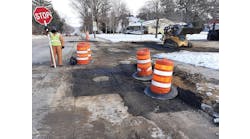The goal of "Keeping good roads good" is behind
a growing number of pavement preservation programs nationwide. Information on
what states, industry and others have accomplished can now be found on a new CD
available from the Federal Highway Administration (FHWA), National Pavement
Preservation Forum II: Investing in the Future (Publication No.
FHWA-IF-03-019).
The CD contains presentations and papers from the National
Pavement Preservation Forum II, which was held in San Diego, Calif., in
November 2001. The conference gave participants an opportunity to share success
stories, detail challenges and discuss the future of pavement preservation. The
event, which was a follow-up to the 1998 Forum for the Future, was sponsored by
the Foundation for Pavement Preservation, FHWA and the California Department of
Transportation (Caltrans).
"Keeping good roads good" involves the timely
application of carefully selected treatments to maintain or extend a
pavement's service life. These treatments may include various types of
surface seals, thin lift overlays and crack sealing for asphalt pavements.
Treatments for concrete pavements might include crack and joint sealing,
diamond grinding and retrofit dowel bars. The key is to apply the treatments
when the pavement is still in good condition, with no structural damage.
Placing a treatment too late will result in poor performance, while applying
treatments too early can cause other pavement problems and use up funds before
they are needed. Applying the right treatment to the right road at the right
time allows highway agencies to get the most out of their maintenance dollars.
Conference participants stressed the importance of education
and awareness as vehicles for promoting pavement preservation. Other keys to
success cited by forum participants were:
* Adequate dedicated funds;
* Effective marketing of preventive maintenance;
* Support from management;
* Legislative support;
* Training and buy-in of workers; and
* Public awareness of the financial benefits of
preventive maintenance.
Conference co-sponsor Caltrans began its pavement
preservation efforts in 1992 and now issues an annual Pavement Condition
Report, which it uses to determine high-priority needs. The agency also
developed 10-year pavement goals, which were implemented in 1998. These goals
include reducing the backlog of distressed lane miles from 14,000 to 5,000 by
2008. Preventive maintenance work completed to date has included applying a
1.2-in. asphalt rubber overlay to 150 lane miles of I-5 in Fresno. The work,
which was performed by the Granite Co., had to be completed in 65 days and come
with a one-year warranty. The overlay "improved the ride dramatically and
extended the pavement life by 10 additional years," said conference
co-chair Larry Orcutt of Caltrans.
Forum participants noted that training is fundamental to
spreading the word about pavement preservation.
In response to state and industry needs, FHWA has developed
a series of pavement preservation training courses. Two courses are currently
being offered to highway agencies through FHWA's National Highway
Institute (NHI), while two more are expected to be available by fall 2003.
Pavement Preservation: The Preventive Maintenance Concept is targeted toward
highway agency decision makers, management, senior maintenance staff and others
who have the ability to create and fund department programs and initiatives.
Selecting Pavements for Preventive Maintenance targets engineers and field
supervisors who make decisions about which roads receive treatment and when.
Still under development are courses on Design and Construction of Quality
Preventive Maintenance Treatments and Pavement Preservation: Integrating
Pavement Preservation Practices and Pavement Management.
Also important to the success of pavement preservation
programs is documenting the
benefits of preventive maintenance. As forum participants noted, data must be
accurate and it also should be accesssible.
To obtain a copy of the Forum II CD, contact Steve Mueller
at FHWA, 202/366-1557; fax: 202/366-9981; e-mail: steve.mueller@fhwa .dot.gov.
